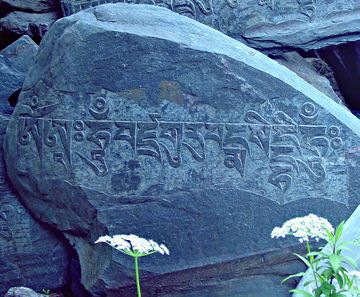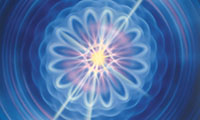Golden Mantra


the Spoken Word
For centuries, devotees of Padma Sambhava have received blessings by invoking his mantra, Om Ah Hum Vajra Guru Padma Siddhi Hum. This Sanskrit mantra is called the Vajra Guru mantra. This is the mantra that the ascended masters call the Golden Mantra.
The mantra means: “Padma Sambhava, who arose from a lotus, please grant me the ordinary and supreme accomplishments, HUM!” (A “Vajra Guru” is a being who has fully mastered the path of Vajrayana.)
Purpose of the mantra
Traditionally Padma Sambhava’s mantra is invoked to create peace and harmony as the antidote for the confusion and turmoil of this dark age. Padma Sambhava instructed Yeshe Tsogyal that his mantra should be used to avert the evils of a coming period of great darkness.
A Tibetan terma text records the dialogue between himself and Yeshe. Yeshe Tsogyal spoke:
I see that there will come a time in the distant future when human beings will possess fickle intellects and ever changing opinions. They will be very excitable, impatient, and excessively prone to violence. They will cling to heretical views regarding the Holy Dharma. In particular, they will slander and belittle the Doctrine of the Supremely Secret Mantras. At that time, for all sentient beings, the three great evils of disease, poverty, and warfare with terrifying weapons will greatly increase.
In particular, there will come a time of terrible suffering for Tibet and the Tibetan people when the troubleswill spread with great devastation across the three regions of China, Tibet, and Central Asia; just like when a nest of ants is broken open the ants swarm out....
In such evil times, it will be extremely difficult to avert or reverse those trends. In such times as those, O Guru, if one should rely solely on your sadhana which is the Vajra Guru Mantra, what benefit and advantage shall come from this?
Then the Great Master spoke:
O faithful daughter, what you have said is very true. But in such future periods of time as those, it is still certain that from practice there shall come forth benefits both immediate and ultimate for all sentient beings.
Guru Rinpoche said that if a monk or even a layman
... of devout faith or a woman of good character, having intensively cultivated the intention to attain Enlightenment ... repeat the essence of the Vajra Guru Mantra a hundred times or a thousand or ten thousand or a hundred thousand or a million or a hundred million times or as many times as possible, the resulting power and benefits shall be inconceivable to the human mind. Moreover in all the directions of space—disease, poverty, warfare, hostile armies, civil strife, famine, dire prophecies and ill omens—all these evils shall be averted.[1]
Meaning of the mantra
As with all mantras, each word of the Golden Mantra has a special significance that goes beyond the literal translation. Therefore the mantra can be interpreted and practiced on many levels. When you understand the profound meaning of the mantra, you are endowing it with your own sacred fire and directing what you hold in mind as your concept of the mantra to the entire universe.
Dilgo Khyentse says:
This mantra is the life and heart, the quintessence of Guru Rinpoche; it is, in fact, Guru Rinpoche in the form of sound.[2]
The mantra is Padma Sambhava.
The Lotus-Born Guru and his mantra are inseparable. When we utter his mantra, which includes the name of the guru, it is like repeatedly calling on someone whose response is unfailing. If we pray, reciting his mantra one-pointedly, there is no doubt whatsoever that Guru Rinpoche will turn his compassion toward us and grant his blessings.[3]
On another level of meaning, the first three syllables of the mantra, Om Ah Hum, are three bija (or “seed”) syllables that enable one to traverse three planes of consciousness—universal, ideal and individual—symbolized in the Dharmakaya, Sambhogakaya and Nirmanakaya.
Om signifies the point of origin, the essence and universality of the Dharmakaya. Ah is for the experience of inspiration or inspirational delight through the Sambhogakaya [your Holy Christ Self]. Hum represents expression and spiritual realization at the level of the Nirmanakaya [the body of the saint].
According to the esoteric Buddhist teaching, the disciple’s invocation of the seed syllables Om Ah Hum releases the light and energy necessary for the eradication of all wrongs ever done through his body, speech or mind. This light and energy also transfer to him the qualities and blessings of the body, speech and mind of the Buddhas or of one’s Guru.
In the case of the Vajra Guru Mantra, the devotee’s goal is to have his body, speech and mind become one with the body, speech and mind of Padma Sambhava.
He the plus, we the minus; he the masculine, we the feminine; he the Spirit universe that we desire to have converge with our Matter universe, our body. When we give the mantra, it is the way through the Divine Mother that all beings of Light in the Spirit cosmos can converge at this point of our physicality. They literally place their Electronic Presence, a duplicate or a double of themselves, over us.
The word Vajra in this mantra signifies the union of the Dharmakaya, Sambhogakaya and Nirmanakaya. It means “diamond,” “adamantine” or “thunderbolt.”
Dilgo Khyentse explains its significance: “Vajra indicates absolute mastery or realization of the indivisibility of the three kayas [the three bodies].”[4]
Antidote to the “five poisons”
Buddhists believe that Padma Sambhava’s mantra has the power to vanquish the “five poisons,” which are the antithesis of the wisdoms of the Dhyani Buddhas. The devotee seeks to be conferred with these wisdoms because they will give him the ability to transmute the five poisons. The five poisons are the obstacles to his spiritual progress and to his realization of Buddhahood.
The word Vajra represents Mirrorlike Wisdom, the wisdom of the Dhyani Buddha Akshobhya. Mirrorlike wisdom allows one to see all things in their true nature and reflects all things uncritically and calmly. Akshobya’s Mirrorlike Wisdom overcomes the poison of anger, hate and hate creation.
The word Guru in the mantra represents the Wisdom of Equality, or inner wisdom, the wisdom of the Dhyani Buddha Ratnasambhava. The nonegoistic Wisdom of Equality embodies the principle of the solidarity of all beings as it sees all things with divine impartiality. Ratnasambhava’s Wisdom of Equality vanquishes the poison of spiritual, intellectual and human pride.
The word Padma symbolizes fearless compassion and Discriminating Wisdom, the wisdom of the Dhyani Buddha Amitabha. Discriminating Wisdom confers inner vision and spiritual discernment, separating inordinate desire from ordinate desire. It is called the wisdom of clear sight that can perceive the causes of karmic conditions and therefore make the choice to no longer engage in those causes. Amitabha’s Wisdom of Equality conquers the poisons of the passions—all cravings, covetousness, greed and lust.
Siddhi represents All-Accomplishing Wisdom or Wisdom That Accomplishes All Works, the wisdom of the Dhyani Buddha Amoghasiddhi. Siddhis are powers or abilities acquired through the practice of yoga. The supreme siddhi is Enlightenment. Amoghasiddhi’s All-Accomplishing Wisdom transmutes the poisons of envy and jealousy.
Hum is the final syllable of the mantra. In some interpretations, it signifies the Wisdom of the Dharmadhatu, the Wisdom of the Dhyani Buddha Vairochana, which consumes the poison of ignorance. In Tibetan Buddhism, Hum is rich in symbolic meaning. It anchors the mantra in the human heart, sheltering it and bringing it to maturity.
Lama Govinda writes: “OM is like the sun, but HUM is like the soil, into which the sun’s rays must descend in order to awaken dormant life.”[5]
Lama Govinda explains that after the disciple has experienced universal consciousness, he returns to the human plane, “on which all attainments are translated into life and deed. The place of this experience is the human heart, in which the ‘Diamond Being,’ i.e. Vajrasattva, is realized and becomes an ever-present force in the seed-syllable HUM.”[6]
The ascended masters teach that Vajrasattva’s Diamond Will of God counteracts the poisons of non-Will and non-Being: fear, doubt and non-belief in God, the Great Guru. Padma Sambhava’s Wisdom of Resolution and World Transmutation vanquishes world chaos created by the poisons delivered by the Four Horsemen of the Apocalypse.
Importance of giving the mantra
In a dictation given on New Year’s Eve 1991, beloved Durga said:
How very close to you and this messenger is Padma Sambhava. Therefore, do not neglect his mantra,... Om Ah Hum Vajra Guru Padma Siddhi Hum. It is your key at this level of service for the entering in to the hearts of all those Buddhas and Bodhisattvas whose lineage goes back to the Great Central Sun, back to the heart of the Godhead.[7]
Lord Maitreya has urged us to let Padma Sambhava’s mantra ring in our soul and our heart:
Give the mantra of Padma Sambhava thirty-three times and celebrate your soul’s ascent each day to the secret chamber of your heart, to the altar of being. Life is empty when you do not do this. When you do not do it, you do not even know just how empty your life is. And you do not know how full it can be when and if you enter into the practice of keeping your appointment with Maitreya, with Gautama Buddha, with the bodhisattvas. Give it thirty-three times, beloved ones.[8]
See also
Sources
Mark L. Prophet and Elizabeth Clare Prophet, The Masters and Their Retreats, s.v. “Padma Sambhava.”
Elizabeth Clare Prophet, July 2, 1992.
- ↑ W. L. R. Sanderson, Vajra Guru Phan-yon: Commentary on the Mystic Syllables and the Benefits of the Vajra Guru Mantra (Newport Beach, Calif.: Vajrayana Buddhist Churches of America, 1998), pp. 2, 3.
- ↑ Dilgo Khyentse, The Wish-Fulfilling Jewel: The Practice of Guru Yoga According to the Longchen Nyingthig Tradition (Boston: Shambhala, 1988), p. 60.
- ↑ Wish-Fulfilling Jewel, p. 65.
- ↑ Wish-Fulfilling Jewel, p. 61.
- ↑ Lama Angagrika Govinda, Foundations of Tibetan Mysticism (London: Rider & Co, 1960), p. 130.
- ↑ Foundations of Tibetan Mysticism, p. 187.
- ↑ Durga, “The Power of Confrontation,” Pearls of Wisdom, vol. 35, no. 5, February 2, 1992.
- ↑ Lord Maitreya, “To Restore the Christhood of America!” Pearls of Wisdom, vol. 35, no. 42, October 11, 1992.
